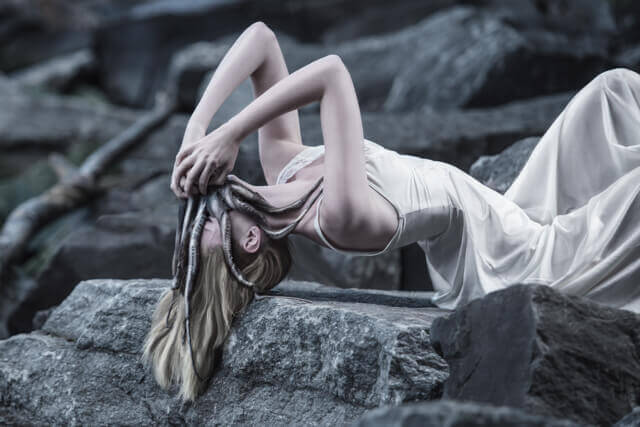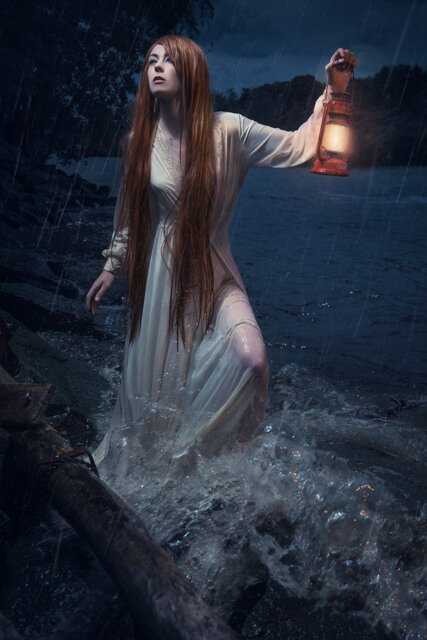It’s not very often that someone comes up to you and asks you to slap some seafood on their face so when Jen Brook enlisted me to take part in her Dreamcatcher project I jumped on the opportunity.
The shoot was an adventure start to finish – from sourcing our octopus, changing locations the day of because the rocks we had scouted two days before had flooded over, to actually crawling all over the wet slippery rocks to get the shot. To get the highly entertaining read to finish, I invite you to read the story from Jen’s perspective on her blog.
Small announcement: ThePrintSpace is actually hosting a 9×16″ Kodak Metallic print giveaway of the Shipwrecked shot! Check out the post on facebook for giveaway details!
Check out the BTS video to see some live octopus action, graciously provided to us by Nicolas Beauchemin:
–
What makes a photographer unique is in the way they see the world around them and how they choose to capture it.
In the three shots taken that day, they were all taken at the same location. You’ll notice in all three shots a long thick branch crossing the image… yet a combination of focal lengths, lighting techniques and storytelling elements make them completely different images.
Techniques should be thought of as tools to carry forth a vision and not be used as the concept itself.
–
So what are the techniques that were used?
1) Shallow depth of field + Flash in daylight. Solution? Hypersync

For me, I wanted to make sure that all the attention and tension that a person would feel from ripping an octopus off ones face could be clearly captured.
The environment was important just to set a mood, but not more important than to tell a story which meant that I would want to shoot with a shallow depth of field as well as use a longer lens to help compress the perspective and blur the background out even more.
The lighting that day was cloudy and at the time of the shot we had a very flat even lighting which meant no harsh shadows – Great! But that also meant that the lighting on Jen would be flat and unexciting. The solution? Strobes!
A quick lighting test with my D800E told me that I would be shooting at ISO100, f2.8 and 1/1000th. Classic sync speed for strobes is 1/250th but thanks to Pocketwizard’s Hypersync (using the Flex TT5 for those of you who are curious), I was able to get a 1/1000th with my X1600 with relatively little loss of power.
And just like that, by tossing a strobe directly over Jen, we managed to carve her out just a touch from the background, making all the difference in the image.

2) Water in movement, character in focus. Solution? ND filters + Strobe!

Since Jen only needed one shot with the octopus for her concept, we figured that I might as well make use of the opportunity to tell a story of my own which is where the idea of a shipwreck came about. Right before leaving from home, I went scrounging around in the garage and found an old lantern, some chains and pieces of wood that were lying around the house that I thought would make some great props to imply a shipwreck.
We tossed the pieces around the set, keeping in mind the rules of composition and had Jen find a position that she could actually comfortably hold without moving too much.
I knew that I wanted to shoot a wider shot but decided that I wanted to avoid the distortion that a 14-24 would give me and settled for the 24-70.
I had decided in my mind that having the waves wispily wrapping around Jen would really bring the mood and flavour of the image together and used the image as an excuse to finally squeeze the wallet to treat myself to a proper 3 stop ND filter and a holder. An ND filter, for those of you who don’t know what it is, actually is the equivalent of sunglasses and just dims the entire image down which allows you to shoot brighter scenes at a longer shutter speed.
The reason I went for a proper square filter as opposed to a Variable ND was that in my experience, there was a distinct loss in sharpness to images created with a Variable ND. Besides, Joey L uses them and he’s awesome.
Combining flashes with ND filters is always a challenge because by knocking down the ambient light you also knock down flash power. I had to toss my strobe on max power and figure out what the longer shutter speed I could get with the highest possible aperture to have everything properly exposed.
From there, it was simply about waiting for the right wave to hit to get the right texture in the water.
3) Transform day to night, light an unlit lantern. Solution? ND filters + Strobe + gels!

For the final shot of the series, I wanted to create some kind of a sequence to the previous shot… perhaps our heroine picking herself up from the shipwreck and wandering off into the darkness with the red lantern that I had brought.
A couple problems: We’re still in the middle of the afternoon and there was no way to light the lantern (and even if we did it wouldn’t look good).
Luckily, I had my 3 stop ND filter to knock down the sun, completely underexposing the environment.
To light Jen back up, we used the same x1600 in the octobox but this time simply added my Elinchrom Ranger Quadra with an orange gel on a Mogopod coming in from the side to imitate the lighting that would come from a light.
The final touch was done in post production, I added the rain streaks and the lantern’s glow back using Photoshop. If I hadn’t used a strobe, I wouldn’t have gotten the natural highlights on the water, dress, face and hair! 5 seconds of setup, awesome result!
In conclusion
If there’s a technique that you’ve always wanted to try out, why not get out there and actually make it happen! Build a story around an effect, and your images will be that much more powerful. And if you fail?
Well… as Thomas Edison once said, I failed my way to Success.
- A Von Wong and Jen Brook project
- Assistants : Allison B, Jefferey Vincent Malo, Andre DF, Julius Adarna, Guillermo Castellnos
- BTS video: Nicolas Beauchemin
Announcements:
- Just got the most amazing tripod ever from 3 legged thing. Check it out.
I’m hunting for an intern, are you interested? Read more hereUpcoming workshops in Vancouver, Dallas and Malaysia… stay updated here- Finally got some prints up for sale on 500px!
Special Gear used:
- Nikon D800E: B&H | Amazon
- Nikkor 24-70mm f/2.8
- Nikkor 70-200mm f2.8
- Pocketwizard Flex TT5 |Pocketwizard AC3
- Pocketwizard AC9 (nikon)
- Lee Universal Filter Holder (bellows)
- 3 stop LEE 4×4 ND filter
- Custom Brackets Camera Rotating Bracket Kit
- Elinchrom Ranger Quadra Li-Ion Kit
See what else is in my camera bag when I travel!
